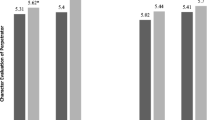Abstract
Previous research has shown that people perceive intimate partner violence (IPV) as more serious in cases involving a male perpetrator and female victim versus other gender combinations. This study is the first to explore reasons for these differences. 181 undergraduates at a U.S. southeastern college rated one of four dating violence vignettes that varied by perpetrator and victim gender. Participants viewed male-on-female violence as more frightening primarily because males are stronger and bigger than female perpetrators. Physical differences were rated as significantly more important causes of fear than other personality/relationship dynamics. Because males are actually stronger and bigger than females, it appears that gendered perceptions of violence are based in real-world knowledge of gender differences, not merely gender stereotypes.

Similar content being viewed by others
References
Archer, J. (2000). Sex differences in aggression between heterosexual partners: A meta-analytic review. Psychological Bulletin, 126, 651–680.
Australian Bureau of Statistics. (2006). Personal safety survey: Australia (Reissue). Sydney: Author.
Browne, A., & Finkelhor, D. (1986). Impact of child sexual abuse: A review of the research. Psychological Bulletin, 99, 66–77.
Cormier, N. S., & Woodworth, M. T. (2008). Do you see what I see? The influence of gender stereotypes on student and Royal Canadian Mounted Police perceptions of violent same-sex and opposite-sex relationships. Journal of Aggression, Maltreatment, & Trauma, 17, 1–26.
Durose, M., Harlow, C. W., Langan, P. A., Motivans, M., Rantala, R. R., & Smith, E. L. (2005). Family violence statistics including statistics on strangers and acquaintances. Washington, DC: Bureau of Justice Statistics.
Dutton, D. G. (2010). The gender paradigm and the architecture of antiscience. Partner Abuse, 1, 5–25.
Finkelhor, D., Turner, H., Ormrod, R., & Hamby, S. (2009). Violence, abuse and crime exposure in a national sample of children and youth. Pediatrics, 124, 1411–1423.
Hall, K. (2009, June 23). Famous couples with taller women: Is height just a number? Retrieved from http://www.huffingtonpost.com/2009/06/14/famous-couples-with-talle_n_214948.html.
Hamby, S. L. (2004). The spectrum of victimization and the implications for health. In K. Kendall-Tackett (Ed.), Health consequences of abuse in the family: A clinical guide for practice (pp. 7–27). Washington, DC: American Psychological Association.
Hamby, S. L. (2009). The gender debate on intimate partner violence: Solutions and dead ends. Psychological Trauma, 1, 24–34.
Hamel, J. (2007). Toward a gender-inclusive conception of intimate partner violence research and theory: Part 1, Traditional perspectives. International Journal of Men’s Health, 6, 36–53.
Hamel, J., Desmarais, S., & Nicholls, T. (2007). Perceptions of motives in intimate partner violence: Expressive versus coercive violence. Violence and Victims, 22, 563–576.
Harris, R. J., & Cook, C. A. (1994). Attributions about spouse abuse: It matters who the batterers and victims are. Sex Roles, 30, 553–565.
Holtzworth-Munroe, A., Smutzler, N., & Bates, L. (1997). A brief review of the research on husband violence, Part III: Sociodemographic factors, relationship factors, and differing consequences of husband and wife violence. Aggression and Violent Behavior, 2, 285–307.
Houry, D., Rhodes, K. V., Kemball, R. S., Click, L., Cerulli, C., McNutt, L., et al. (2008). Differences in female and male victims and perpetrators of partner violence with respect to WEB scores. Journal of Interpersonal Violence, 23, 1041–1055.
Hyde, J. S. (2005). The gender similarities hypothesis. The American Psychologist, 60, 581–592.
Institute for Women’s Policy Research. (2009). The gender wage gap: 2008. Washington, DC: Author.
Langhinrichsen-Rohling, J. (2010). Controversies involving gender and intimate partner violence in the United States. Sex Roles, 62, 179–193.
Lindle, R., Metter, E., Lynch, N., Fleg, J., Fozard, J., Tobin, J., et al. (1997). Age and gender comparisons of muscle strength in 654 women and men aged 20–93 yr. Journal of Applied Physiology, 83, 1581–1587.
Ogden, C. L., Fryar, C. D., Carroll, M. D., & Flegal, K. M. (2004). Mean body weight, height, and body mass index, United States 1960–2002. Atlanta: National Center for Health Statistics, Centers for Disease Control and Prevention.
Pierce, C. A. (1996). Body height and romantic attraction: A meta-analytic test of the male-taller norm. Social Behavior and Personality, 24, 143–150.
Poorman, P., Seelau, E. P., & Seelau, S. M. (2003). Perceptions of domestic abuse in same-sex relationships and implications for criminal justice and mental health responses. Violence and Victims, 18, 659–669.
Seelau, S. M., & Seelau, E. P. (2005). Gender-role stereotypes and perceptions of heterosexual, gay and lesbian domestic violence. Journal of Family Violence, 20, 363–371.
Sorenson, S. B., & Taylor, C. A. (2005). Female aggression towards male intimate partners: An examination of social norms in a community-based sample. Psychology of Women Quarterly, 29, 78–96.
Sorenson, S. B., & Thomas, K. A. (2009). Views of intimate partner violence in same-and-opposite-sex relationships. Journal of Marriage and Family, 71, 337–352.
Stark, E. (2010). Do violent acts equal abuse? Resolving the gender parity/asymmetry dilemma. Sex Roles, 62, 201–211.
Straus, M. A. (1993). Physical assaults by wives: A major social problem. In R. Gelles & D. Loseke (Eds.), Current controversies on family violence (pp. 67–87). Newbury Park: Sage.
Straus, M. A. (2005). Gender and partner violence in world perspective: Some results from the International Dating Violence Study. Paper presented at the 9th International Family Violence Research Conference, Portsmouth, NH.
Straus, M. A., & Gelles, R. J. (1990). Physical violence in American families: Risk factors and adaptations to violence in 8, 145 families. New Brunswick: Transaction.
Tjaden, P., & Thoennes, N. (2000). Extent, nature, and consequences of intimate partner violence: Findings from the national violence against women survey. Washington, DC: National Institutes of Justice.
Author information
Authors and Affiliations
Corresponding author
Rights and permissions
About this article
Cite this article
Hamby, S., Jackson, A. Size Does Matter: The Effects of Gender on Perceptions of Dating Violence. Sex Roles 63, 324–331 (2010). https://doi.org/10.1007/s11199-010-9816-0
Published:
Issue Date:
DOI: https://doi.org/10.1007/s11199-010-9816-0




